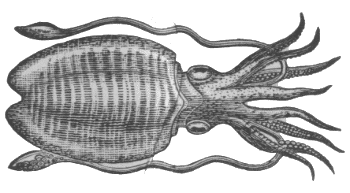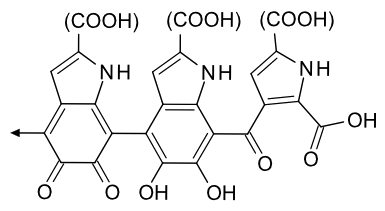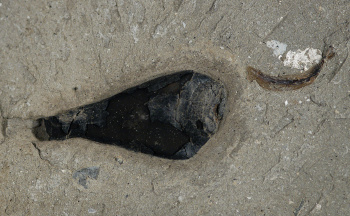Jurassic Ink
May 29, 2012
As a necessity,
scientists of
my generation often became expert
draftsmen. Draftsmen are also known as draughtsmen, although
beer is usually not involved. There were no
computer applications for creating
publication-quality data plots or
diagrams, so everything was
drawn by hand. In my case, the drawing often involved
schematics of
electronic circuits, which are somewhat more complicated than most drawings.
To do this
drafting, I had a set of metal
compasses,
rulers,
triangles, and
circle templates; and I also had an exquisite set of
pens (see photo). These pens were engineered to produce lines of precise width using
India ink , a
colloid of fine
carbon soot in an
aqueous vehicle. Lines made with India ink are very
opaque, and they are easily reproduced.

Staedtler Mars pen set,
circa 1980.
Photograph by author)
Since India ink is made from carbon particles, these form a
percolation network of low
conductivity when the ink dries. Thus, India ink allows attachment of wires to measurement specimens when a highly conductive attachment is not required. It is especially useful in
high voltage circuitry to allow a very high resistance
ground return for components.
Octopus ink has had been used as a
plot thickener in
cartoons, but in
antiquity it was actually used as an ink. The color,
sepia (
color code #5E2612), is associated with the ink of one order of
cephalopods, the
cuttlefish, which was harvested for ink.

Drawing of a cuttlefish (Sepia officinalis), from the 1911 edition of Webster's Dictionary.
(Via Wikimedia Commons))
Ink is nearly ubiquitous among cephalopods, so a natural question would be when such an
evolutionary adaptation got started, and whether ancient cephalopod ink was different from modern ink. The problem here is that you need a specimen of primordial ink. A large international team of scientists has analyzed traces of ink from two ink sacks associated with
fossils of 160-million-year-old giant cephalopods from the
Jurassic period.[1-2] The fossils were discovered two years ago in
England.[1]
They found
chemical traces of
melanin, a common
biological pigment for both
plants and
animals. The chemical structure was essentially identical to the melanin (specifically,
eumelanin) found in the ink of modern cuttlefish.

Eumelanin, a common biological pigment.
(Structural diagram by Roland Mattern, modified, via Wikimedia Commons))
The fossils with ink sacks were found in
Christian Malford,
Wiltshire,
England, somewhat west of
London, by Phillip Wilby of the
British Geological Survey. One of the ink sacs is the only intact ink sac ever discovered.[1]
Wilby sent samples to
John Simon, a
chemistry professor at the
University of Virginia, and
Japanese chemist Shoskue Ito, both of whom are experts in melanin. Simon and Ito assembled an international team with members from the
United States, the
United Kingdom,
Japan and
India, to chemically examine the fossil evidence in search of melanin, which was found.[1]

(University of Virginia image, used with permission))
That melanin, an
organic compound, should survive after 160 million years, seems quite remarkable, since animal
tissue decomposes quickly. Melanin, however, is more resistant to decomposition, since it's
polymeric. Says Simon,
"Out of all of the organic pigments in living systems, melanin has the highest odds of being found in the fossil record... Though the other organic components of the cephalopod we studied are long gone, we've discovered through a variety of research methods that the melanin has remained in a condition that could be studied in exquisite detail."[1]
The chemical composition of the trace evidence of melanin matched the melanin of modern cuttlefish ink. This affirms the possibility that the ink cloud defense mechanism of such creatures hasn't changed since the Jurassic. Says Simon, "The whole machinery apparently has been locked in time and passed down through succeeding generations of cuttlefish. It's a very optimized system for this animal and has been optimized for a long time."[1]
A paper on this research has been published in the May 21, 2012, issue of the
Proceedings of the National Academy of Sciences.[2]
References:
- Fariss Samarrai, "Cephalopod Ink from Jurassic Period Identical to Modern Cuttlefish Ink, U.Va. Study Shows," University of Virginia Press Release, May 21, 2012.
- Keely Glass, Shosuke Ito, Philip R. Wilby, Takayuki Sota, Atsushi Nakamura, C. Russell Bowers, Jakob Vinther, Suryendu Dutta, Roger Summons, Derek E. G. Briggs, Kazumasa Wakamatsu and John D. Simon, "Direct chemical evidence for eumelanin pigment from the Jurassic period," Proc. Natl. Acad. Sci., online before print May 21, 2012, doi: 10.1073/pnas.1118448109.
Permanent Link to this article
Linked Keywords: Scientist; baby boomer; drafter; draftsmen; draught beer; application software; computer application; scientific literature; data plot; diagram; drawing; schematic; electronic circuit; technical drawing; compass; ruler; triangle; circle; stencil; template; pen; India ink; colloid; carbon; soot; aqueous solution; vehicle; opacity; opaque; Staedtler Mars; percolation network; conductivity; high voltage; electrical ground; octopus; cephalopod ink; ink; plot; cartoon; ancient history; antiquity; sepia<; cephalopod; cuttlefish; Webster's Dictionary; Wikimedia Commons; evolutionary adaptation; fossil; Jurassic; England; chemical compound; chemical; melanin; biology; biological; plant; animal; eumelanin; Roland Mattern; Christian Malford; Wiltshire; South West England; England; London; British Geological Survey; John Simon; chemistry; University of Virginia; Japan; Japanese; chemist; United States; United Kingdom; India; organic compound; tissue; polymer; polymeric; Proceedings of the National Academy of Sciences.